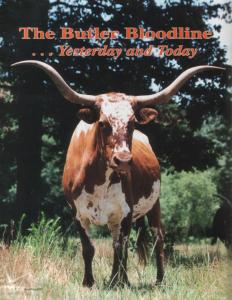 The Butler Bloodline... The Butler Bloodline...
Yesterday and Today
Part 1
By Kaso Kety
Photos by Ron Graham
What type of animal do you envision when a cow is described as "Butler bred"? Most folks might say "Oh, she must be small, white and have huge horns." Well, at least they're right about the horns. Without visiting the ranches of Butler Longhorn breeders, and by only viewing cattle that have gone to market, one cannot gain a true feeling for nor an understanding of what has proven to be one of the most popular and profitable of the "Seven Families" of Texas Longhorns.
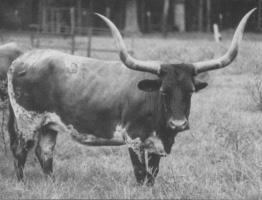
Upper right: Graves 102, a 1976 daughter of Man O'War was bred by Blackie Graves and is owned by Ace Cattle Co.
Above: Graves 54, one of Blackie 's biggest-horned cows. |
For some unknown reason, I have been selected for this undertaking-to help give new breeders a better understanding of this tremendous bloodline. I feel that the best way, to acquaint breeders with the Butler family is to present a brief history of the cattle prior to the death of Milby Butler (for whom the strain was named) along with a general description of those herds which are considered to be distinct Butler lines. While there are many breeders of Butler cattle, these foundation lines have served as the nucleus for today's Butler herds.
In preparing this account, I have found articles by Darol Dickinson, Lorna Bremner and Deborah Sizemore invaluable. Their long hours of interviews and research are greatly appreciated and many of their comments bear repeating here.
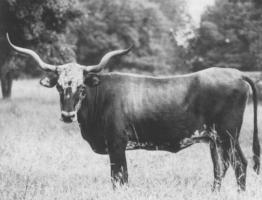
Graves 52, one of Blackie's top -producing foundation cows. |
Milby Butler was born in 1889, and was a cowman at birth, having had a Brahman cow registered in his name when he was one week old. Knowing (or hoping) that cattle would be his son's life, Milby's father G.W. Butler gave him the famous "OT" brand in 1907 or 1908. G.W. had had the brand given to him by his mother around 1872, and apparently the initials "OT" were hers.
Milby's primary interest was in the family's excellent Brahman herd. It was his son Henry who actually started the Longhorn herd, beginning with cattle he had received for working as a hand during the cattle roundups on the open rangeland between Houston and Galveston, Texas. From the time he was ten years old, Henry helped with the roping and branding and took his pay in heifers. "I always took the big-horned ones," Henry said. Their origin was "just old, big-homed east Texas cattle." These became an important part of the Butlers' foundation herd. The Butler family also ran an extensive stock pen and slaughterhouse business. The best cattle were sifted over the years and retained for the growing Longhorn herd.
In 1923 Milby separated the Longhorns from the rest of his cattle. While he was very interested in preserving the native Longhorns, it was not until Henry was away in the service during World War II that Milby took an active interest in raising the cattle. He soon assumed responsibility for the ranch's Longhorn breeding program.
In 1931, the Butlers traded Pat Phelps of Newton County (Texas) two Brahman cows for a white, "flea-bitten" Longhorn cow. This white, speckled cow with red ears, red rings around the eyes and nose, and with red specks on her ankles became the first source of the color trait many people refer to as "Butler color." Henry once described her as a medium-sized cow with a double twist corkscrew horn shape.
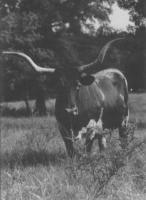
Graves 68, long considered by Blackie to be his best cow. |
In his search for outside Longhorn blood, Milby purchased five cows from Esteban Garcia of Encino, Texas. These cattle were not of the East Texas variety, but were true Mexican cattle. They came off of a dry desert and had been living on cactus most of their lives. They had callouses on their knees and hocks from getting up and down on rocks and cactus. Their mouths were so full of pear spears that their muzzles looked like the backs of porcupines. When the cattle were shipped to the Butlers (at League City, Texas) only two of the five survived. Although of an entirely different bloodline, these cows bore the "Butler" trait of large, corkscrew horns. One cow was red with a white star on her fore head. Christened "Miss John Wayne," she lived to be 37 years old, giving birth to 12 bulls and no heifers. These sons were used as outcross Longhorn blood on the original Butler herd. Milby had Miss John Wayne's head mounted after she died, and it is now in the possession of Butler Longhorn breeder Dewitt Meshell of Trinity, Texas.
The Butlers used many white and roan bulls as herd sires. The main cow herd had been dominated by the solid colors common in most herds of the day. By breeding white bulls on solid cows, many unusual and out standing colors resulted in the offspring. In conversations with Sam Partlow, F.M. "Blackie" Graves and Meshell, they all remember the Milby and Henry Butler herd as being filled with cattle of every color imaginable.
Although he enjoyed the many wonderful colors that would "pop up" in the herd, Milby's true passion was the horn growth the cattle could produce. No one will argue with the fact that Milby bred for horns. His cows were carefully selected and put with the bull that he thought would produce length, base and corkscrew shape in the horns of their off spring. His herd sires were out of the cows with the best corkscrew horns. "Color," Milby would say, "is unpredictable. Breed for horns and you'll get color."
During the mid-1960's, a man named Garnett Brooks worked as a registration inspector for the newly-formed Texas Longhorn Breeders Association of America. He saw the Butler cattle on two occasions. His comments to the TLBAA indicated the following: "the Butler cattle are mostly light colors of cream, dun, grulla and white speckled. I did not see any black cattle. The pastures were
partially chain-linked with excellent gates and working pens. There are many old cattle with the Texas screw-type horns. They are unusual cattle and different from other Longhorn herds. They are bigger-framed cattle than most southeast Texas cattle. Many of the cattle could be considered real outstanding on horns."
Of the second inspection, Brooks recalled that "again we saw the identical type of twisted, big-horned cattle. The cattle were very uniform. They were selected for a specific type of [Milby's] own desire. He felt he had a true type of the old blood."
There are several versions of where and how Milby's cattle were dispersed, but there are some concrete explanations. Some of the Butler cattle were part of Milby's wife's estate, and were sold by private treaty when Mrs. Butler died within a year or two prior to Milby's passing. J.W. Isaacs of Alvin, Texas was among the private treaty buyers, purchasing fourteen two-year-olds.
Immediately following Milby's death, the bulk of his remaining cattle were sold at auction. Approximately eighty percent of the Butler herd was slaughtered. The other twenty percent was purchased by those Longhorn breed era fortunate enough to learn of the sales. These included Dewitt and Sammy Meshell, Ruel Sanders, W.D. and Sam Partlow, Luman Holman and J.W. Isaacs.
Pauline Russell, Milby's secretary kept at least twenty of the best Butler cattle, which she then sold in 1977 at Raywood, Texas. Among the buyers of these animals were Blackie Graves, E.B. "Booster" Stephenson, Wiley Knight and Edward Faircloth.
Milby Butler died on October 16, 1971, a few months before his 83rd birthday. Nearly twenty years after his death, there still survives an easily identifiable type of Texas Longhorn which bears the Butler name and which may be traced in an unbroken line to the native big-horned cattle of East Texas and the Gulf Coast. It is only by chance that any survive at all. Through the efforts of a few breeders, a precious number of cattle were saved. These small herds were line-bred, with each becoming a closed genetic pool. Many times where these lines have been crossed the resulting offspring have shown size, color and the outstanding horn growth of the original Butler herd. To gain a better perspective regarding these distinct lines and how they interact with one another, it is necessary to examine how and when the cattle were acquired, and by whom.
F.M. "Blackie" Graves and the Legendary Classic and Monarch
Probably the best-known name in Butler breeding is that of F.M. "Blackie" Graves of Dayton, Texas. Blackie first got into raising Longhorn cattle as a hobby in 1962. He was given the bull "Sam" by Henry Butler and then began purchasing cattle from Milby and Henry, ending up with as many as twenty head handpicked from the original Butler herd. A good many of Blackie's cattle, however, including the first, came from the herd of the Partlows of nearby Liberty, Texas. The Partlows had been acquiring cattle from Milby for years, and Blackie was good friends with both families. Blackie continued to raise his Longhorns in relative obscurity until 1977, when he purchased the great bulls Classic and Monarch at the Raywood auction. Pauline Russell had decided to part with all but one of the Longhorns she had retained from Milby's herd, keeping only the legendary cow called Beauty. Beauty would later be purchased by Red McCombs in partnership with Terry and Sid Kelsey and the Y.O. Ranch, with YO Centennial Beauty at her side as a calf. That would wait, however, as an important chapter in Longhorn history would begin to unfold this day at the Raywood auction.
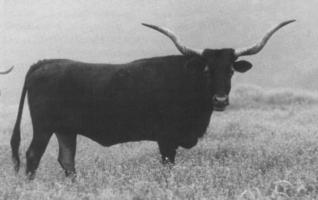
Rose Red, a 1972 straight Butler cow from the Partlow herd has produced more dollars' worth of calves than any other Longhorn female. |
Classic was a four-year-old bull with horns that measured 59". He became the first bull on record with horns over 60 inches. In addition to this impressive young bull, Blackie brought home a two-year-old bull named Monarch. His hornpread would measure a remarkable 56" at just three years of age. These two bulls are closely related, with Classic being calved out of Beauty by Bevo and Monarch being a son of Bevo and Lady Butler, a cow that is a full sister to Classic. Blackie also purchased two bulls for Dr. E.B. Stephenson, one being named Reveille, the other his full brother (which would soon be a steer) called Loco. Another important development that day was Wiley Knight's purchases of both Butler Boy and Lady Butler. All of these Longhorns were products of the Bevo Beauty combination.
Over 90% of the 60-inches-and over animals in the breed were sired by either Classic or Monarch. While being two of the most popular bulls ever, they have probably been two of the most misunderstood bulls in Longhorn history as well. They have been judged as much for their color as for their horns, which is an unfair discrimination against both of them. For breeders who have understood how to utilize Classic and Monarch, the results have been tremendous. Size and color have proven to be nearly as consistent as the ability to produce horn growth. A visit to Blackie Graves' place will quickly convince even the most skeptical folks of the true siring abilities of Classic and Monarch. There is at least one solid, one speckled, one spotted and one lineback for every white cow you're likely to see.
Blackie had good fortune in that the bulls not only crossed well, but really clicked with his foundation cattle and their daughters by Sam and Man 0' War. In 1972, Blackie received Man 0' War as a gift from Henry Butler to use as new blood on Blackie's "Sam"-bred cattle. Henry told Blackie that the bull was a product of some of their best Butler blood. Man 0' War sired cattle for Blackie that are ranked among the finest Butler Longhorns ever produced. The bull spent his last few years at Julius Roberts' ranch near Walsenburg, Colorado, and he lives on through a small, precious amount of semen that still exists.
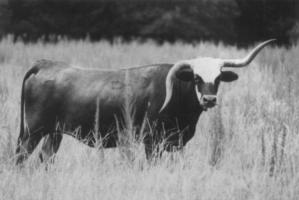
Maressa, one of the last known cows to actually be "Partlow-bred," is still a top producer. She is owned by Ace Cattle Company. |
Blackie has primarily used Dode's Boy, a 1978 son of Conquistador and Miss Liberty 10, on his Classic and Monarch daughters. He acquired this bull from his good friend Dode Partlow. Dode's Boy is a full brother to Boomtown, Stetson and the excellent cow Vivacious. If you should ever have the good fortune of getting to visit Blackie Graves and see his herd, you'll have an experience you won't forget. A true Longhorn lover cannot help but be awestruck by the number of tremendous cows as well as the amount of horn present. Age has caught up with most of the foundation cattle, as many were born in the late sixties and early seventies, yet their offspring remain to carry on Blackie's vein of the Butler bloodline. While Blackie's record for selling high-dollar cattle may never be matched, the dozens of 50"-horned cows that were sold are hardly missed when confronted with the virtual sea of horns you'll see on the Graves ranch.
What seems even more remarkable than this is the list of outstanding Butler bulls that have been produced. Out of Blackie's herd have come Bold Ruler, Major 150, F.M. Graves 117, Pecos, Redbird, F.M. Texan, F.M. Dayton, F.M. Graves Ruler, Prince Classic, Classic Jr., Classic's Majestic, Redmac Beau Butler, Classic Reflection, Classic Especial, Classical F.M., Duke Monarch, Count Monarch and Mr. Graves to name just a few of the more prominent. It's interesting to note that although Bold Ruler came out of Blackie's herd, he was sold before he had bred any cows. He would earn his place among the breed's greatest bulls while being used nearly exclusively in outcross situations. Only in a handful of cases was he bred to straight Butler females, although in recent years many more of these matings have occurred through artificial insemination and embryo transfer. These straight Butler-Bold Ruler offspring show color and horn shape much different than that typically produced when he was bred in outcross matings. His true potential in straight Butler programs has only begun to be felt even now, years after his death.
Over the years, Blackie has incorporated other families of Longhorns into his Butler base. These are selected for the traits Mr. Blackie finds to be most important: the ability to raise a good calf every year, conformation, structural correctness and of course, a great set of horns. His preference for bulls remains in Butler-bred herd sires. While the demands on his time and his health have forced Mr. Blackie to consider cutting back his Longhorn operation, those that know him best know he will always keep a few of the "good ones."
The Partlow Family: 35 Years of Butler Breeding
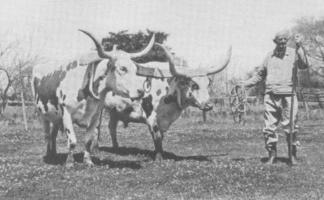
R.G. Uncle Gerry Partlow with Tom & Gerry, a yoke of straight Butler Longhorn steers. Photo taken in early 1960 s at Liberty, Tex. |
For over 35 years the Partlow family of Liberty, Texas has raised Butler cattle. W.D. "Dode" Partlow and Milby Butler were close friends and got along well over the years as both were real "old-time" cattlemen. Dode and his nephew, Sam, assumed most of the responsibility for the Longhorn herd. The Partlow herd is generally considered to be the "cream" of Butler Longhorn genetics. As Sam says, "Milby would come over every so often, maybe once or twice a year. He would swap out bulls or maybe bring some heifers. They were always outstanding individuals and all he would say is that they were some of his best breeding." It is from this herd that Blackie Graves obtained many of his foundation cattle. In 1979, Dode Partlow became very ill. At that time, Darol Dickinson purchased the majority of the Partlow herd and took them back to Colorado with him. Dickinson was very heavily involved in embryo transfer, and the cattle proved to be among the most productive the breed has ever seen. Looking back, it seems almost impossible for one herd to contain so many cattle of a quality scarcely available in the breed before or since. The list includes Vivacious, Rose Red, Maressa, Shenandoah, Bonanza, Constant Comment, Miss Liberty 49, Rella, Golden Slippers, Majestic and Mona Leta. These females had not only breathtaking beauty but they had tremendous productivity as well, which allowed them to be highly promoted. This has made the Partlow cattle one of the best- known and respected of the Butler lines. Sam Partlow retained several Longhorns at this time in order to maintain the "Partlow family Longhorn tradition." Today, despite the fact that health considerations prompted the sale in 1990 of many of these cattle to the Ace Cattle Company, Sam continues to keep a small herd because "as long as there are Partlows, we'll own Longhorns."
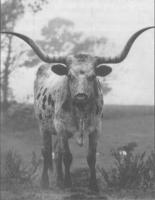
Alicia of 83, a 1983 daughter of Duke Monarch and Princess 2/7, bred by Sam Partlow. |
For much of the eighties Sam has used Duke Monarch. He is a Monarch son out of Graves 98, some of Blackie's best stock. His cross on the Partlow foundation breeding has been exceptional. Many of the bulls Milby bought were simply named Milby and a private herd number such as Milby 1/2, Milby 282, and Milby 89.
The best known Partlow bull is the great Conquistador. Conquistador was purchased as a calf at Raywood by Blackie Graves for Dode Partlow. He was sold at Raywood by Milby. He has proven to be one of the most consistent bulls of all time. The Partlow herd sires have always been described as "true breeding bulls." Bulls descending from this bloodline include Colorado Cowboy, Dode's Boy, Boomtown, Henry B. Dozier, Conquistaroan, and today's Dozemon.
Dode Partlow also owned cattle of Peeler and WR heritage, but these cattle were always the first sold and did not enter significantly into the gene pool, as the focus has always been on breeding Butler cattle. The Partlow herd, like the Holmans' show many vibrant colors and patterns although Sam will admit to his share of white calves over the last 35 years. However, he insists that solid, dark colored cattle have long been dominant in the herd. The horn growth within the Partlow herd is tremendous with the Butler trait for double twist horns in full abundance. When one marvels at the magnitude of the genetics present, one can't help but wonder if Milby might have speculated as to what would become of his beloved longhorns upon his death and felt they would be "safe" with the Partlows. A visit to Liberty, Texas will assure you that Milby couldn't have left them in better hands.
Michael McLeod, Maribeth Vineyard and the Lepper Family
In 1977 Peggy Swaboda found herself in the middle of a hard winter with a herd of Texas Longhorns she had inherited from her father, Forrest Lepper. Lepper had acquired them when the Butler herd was dispersed in the early seventies. She hadn't been prepared to care for the cattle and it showed. The herd was in pitiful shape and it was obvious they would have to be sold. The herd was brought to the attention of Maribeth Vineyard and her partner, Michael McLeod. Maribeth was more than a little reluctant to buy the cattle, but Michael had wanted to own longhorns since childhood, and his persistence would finally pay off when they ended up purchasing the bulk of the herd.
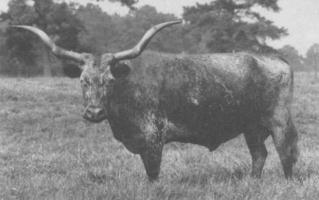
Sissie L, a daughter of Thomas and Sara L, is a fine example of the Lepper family of Butler cattle. |
Since very little was known about the breeding records of the cattle, the herd was inspected by past TLBAA president J.W. Isaacs, and hardship registered in accordance with TLBAA regulations. The herd included the great old Butler sire, Thomas. Thomas had been used and registered by Milby, but the other cattle were registered as "unknown" except for those known to be Thomas' offspring. At the time of registration, a combination of age and poor physical condition had rendered Thomas unable to breed. Pappy L the only other breeding age bull, was listed as the service sire. Pappy "L" and several of the cows were purchased by Maribeth and Michael's neighbor, Dr. Harmon Knight. Dr. Knight used Pappy "L" for many years with great success, yet the success achieved by Mr. J.W. Isaacs may never be matched. Every calf produced matured into a herd-topping individual. He leased Pappy "L" for a season before Dr. Knight took possession of him. In Mr. Isaacs' words, "Every cow was top line, and every bull calf was a herd sire." A stunning example of Pappy's ability as a herd sire is the fabulous Anita.
The remaining cows were moved by Maribeth and Michael to the West Ward Ranch at Vanderbilt, Texas. In the early years it was felt the cattle were too inbred by pedigree, so several outcross bulls were used. The Lepper cows crossed well with these Texas Ranger and Hondo bred bulls, but it was rather by accident that they found their "super sire." One of the two bull calves in the original herd was out of the number ten cow, Kerry Belle "L". He became known as He's a Ten. When bred back to females from the original herd, the success has been tremendous. What is most amazing about the herd, is that despite the intense line breeding done, the herd excels in fertility, size, and color. Several of the original cattle are still alive and producing as they enter their twenties.
Maribeth retired from the Longhorn business in 1988, at which time Michael purchased her half of the herd. He continues to raise longhorns with the help of wife, Jackie and sons, Wesley and Michael Matthew. The present herd numbers in excess of 400 head with some 140 straight Butlers including 30 all Leppers, descendants of the original group. Michael states that although he has owned many cattle representing all the "families," the Leppers remain his favorites. "Those cows breed every year, milk heavy, and always produced lots of horn and they've done it every year for the last fourteen." It is interesting to note that despite the fact that Thomas was a predominately white colored bull, and that the herd carries the highest amount of his blood, the cattle continue to be dominated by dark colors of reds and browns. The Leppers are probably the largest bodied line of all Butlers with most cows weighing between one thousand and twelve hundred pounds. Michael is a true horn lover and it shows through his selection for horn length without sacrificing shape. The twist horn factor remains very strong in the herd.
Today, several excellent He's a Ten sons carry on his legacy. Michael has also started introducing unrelated straight Butler bulls on the cow herd. The most significant contribution of the herd may be its ability to dispel any notions that the Butler cattle are too inbred to be effective. The Lepper herd has been a closed gene pool for over twenty years, yet it continues to excel in those traits which most define the Texas Longhorn. A visit to Michael's is always as educational as it is enjoyable and strongly recommend one for anyone interested in viewing genetics from the core of the Butler Longhorn herd. The Lepper cattle survive today, as a testimonial to a great old bull's worth as a sire and a boy's dream of owning Texas Longhorns.
Material is courtesy of LonghornJournal.com |
|
|